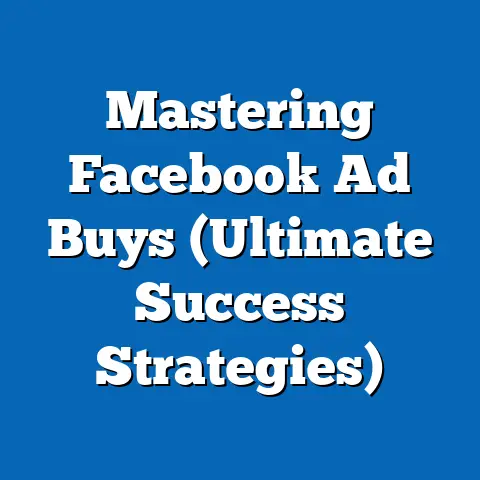Master Facebook Ads for SMMA Success (Proven Strategies)
In an era where sustainability has become a global priority, businesses and marketers are increasingly aligning their strategies with eco-friendly values to resonate with environmentally conscious consumers. This shift is not just a passing trend but a profound societal movement, driven by growing awareness of climate change, resource depletion, and the need for sustainable practices. As social media marketing agencies (SMMAs) navigate this landscape, leveraging platforms like Facebook Ads offers a powerful opportunity to promote eco-friendly brands and initiatives while achieving measurable success for clients.
Eco-friendly options, often associated with green products, renewable energy, and sustainable lifestyles, have gained traction across generations, particularly among Millennials and Gen Z, who prioritize ethical consumption. The historical context of the environmental movement—spanning from the 1960s counterculture and the establishment of Earth Day in 1970 to the modern-day Paris Agreement—has shaped a cultural expectation for businesses to adopt sustainable practices. Societally, the implications are vast: eco-conscious marketing can enhance brand loyalty, attract purpose-driven customers, and contribute to broader environmental goals, but it also demands authenticity to avoid accusations of “greenwashing.”
For SMMAs, mastering Facebook Ads in this context means crafting campaigns that not only drive conversions but also align with these values, balancing profitability with purpose. This article explores proven strategies for achieving SMMA success through Facebook Ads, beginning with an understanding of eco-friendly marketing as a key trend. It delves into audience targeting, ad creative best practices, budget optimization, and performance analysis, while weaving in the broader implications of sustainable marketing in the digital age.
Section 1: Understanding the Eco-Friendly Marketing Landscape
Defining Eco-Friendly Marketing
Eco-friendly marketing involves promoting products, services, or initiatives that minimize environmental harm, often emphasizing sustainability, ethical sourcing, and carbon neutrality. This approach resonates with consumers who value transparency and are willing to support brands that demonstrate a commitment to the planet. For SMMAs, this means tailoring campaigns to highlight a client’s green credentials while maintaining a focus on results-driven advertising.
The rise of eco-conscious consumers has been fueled by increased access to information about environmental issues through social media and digital platforms. According to a 2021 Nielsen report, 73% of global consumers are willing to change their consumption habits to reduce environmental impact, a statistic that underscores the market potential for green-focused campaigns. SMMAs must recognize that eco-friendly marketing is not a niche but a mainstream expectation in many industries.
Historical Context of the Environmental Movement
The environmental movement gained momentum in the mid-20th century, with pivotal events like the publication of Rachel Carson’s Silent Spring in 1962, which exposed the dangers of pesticides, and the first Earth Day in 1970, which mobilized millions for environmental advocacy. These moments shifted public consciousness and laid the groundwork for policies like the Clean Air Act and the establishment of the Environmental Protection Agency (EPA) in the United States. Over the decades, global initiatives such as the Kyoto Protocol (1997) and the Paris Agreement (2015) further cemented sustainability as a societal priority.
For marketers, this historical backdrop provides a narrative framework to connect with audiences. Campaigns that reference these milestones or align with ongoing environmental goals can tap into a collective sense of urgency and purpose. SMMAs leveraging Facebook Ads must understand this context to craft messages that resonate authentically with eco-conscious demographics.
Societal Implications for Marketing
The push for sustainability has reshaped consumer behavior, with implications for brand trust, loyalty, and purchasing decisions. A 2022 study by IBM found that 62% of consumers are willing to pay a premium for sustainable products, while 57% expect brands to take a stand on environmental issues. This creates both opportunities and challenges for SMMAs, as clients seek to position themselves as eco-friendly without alienating skeptical audiences who scrutinize green claims.
Moreover, the societal shift toward sustainability intersects with digital marketing’s emphasis on transparency and engagement. Facebook Ads, with their robust targeting capabilities, allow SMMAs to reach eco-conscious audiences with precision, but they must also navigate the risk of backlash if campaigns appear disingenuous. The broader implication is clear: sustainability is no longer optional but a critical component of modern marketing strategy.
Section 2: Why Facebook Ads Are Essential for SMMA Success
The Power of Facebook Ads in Digital Marketing
Facebook Ads remain one of the most versatile and effective tools for SMMAs due to their vast user base—over 2.9 billion monthly active users as of 2023—and sophisticated targeting options. For agencies managing multiple clients, including those in eco-friendly niches, the platform offers unparalleled reach and the ability to tailor campaigns to specific demographics, interests, and behaviors. This makes it an ideal channel for promoting sustainable brands to audiences who prioritize environmental values.
Unlike other platforms, Facebook Ads provide a range of formats, from carousel ads to video content, enabling creative storytelling that can highlight a client’s green initiatives. Additionally, the platform’s integration with Instagram expands reach across visual and engagement-driven spaces. For SMMAs, mastering this tool is not just about driving clicks but about building brand narratives that resonate with purpose-driven consumers.
Advantages for Eco-Friendly Campaigns
Eco-friendly campaigns benefit uniquely from Facebook Ads’ ability to target users based on interests such as “sustainability,” “organic products,” or “environmental activism.” This precision ensures that ad spend is directed toward audiences most likely to engage with green messaging. Furthermore, the platform’s retargeting capabilities allow SMMAs to re-engage users who have shown interest in eco-friendly content, increasing conversion rates.
A 2022 report by Hootsuite revealed that 48% of social media users discover new eco-friendly products through platforms like Facebook, highlighting the channel’s role in shaping consumer behavior. For SMMAs, this underscores the importance of leveraging Facebook Ads not just for sales but for education and advocacy around sustainability. Success in this space requires a blend of technical expertise and an understanding of cultural trends.
Section 3: Proven Strategies for Mastering Facebook Ads
Strategy 1: Audience Targeting with Precision
Effective Facebook Ads campaigns begin with a deep understanding of the target audience, particularly for eco-friendly brands. SMMAs should use Facebook’s Audience Insights tool to identify demographics that align with sustainability values, such as age groups (e.g., Millennials and Gen Z), geographic locations with high environmental awareness, and interests like “green living” or “renewable energy.” Custom Audiences and Lookalike Audiences further refine targeting by focusing on users who have interacted with similar content or brands.
It’s also critical to segment audiences based on their stage in the buyer’s journey. For instance, awareness-stage ads might focus on educational content about a client’s eco-friendly mission, while conversion-stage ads could highlight specific sustainable products with clear calls-to-action. This nuanced approach ensures that messaging remains relevant and impactful across different touchpoints.
Strategy 2: Crafting Compelling Ad Creatives
Ad creatives are the heart of any successful Facebook Ads campaign, especially for eco-friendly brands where authenticity is paramount. Visuals should reflect sustainability themes—think natural imagery, earthy tones, and symbols like recycling logos—while copy should emphasize transparency and impact, such as “100% biodegradable packaging” or “1 tree planted per purchase.” Video ads, in particular, can showcase a brand’s environmental efforts through storytelling, building emotional connections with viewers.
SMMAs must also test multiple creative variations to identify what resonates most with their audience. A/B testing headlines, images, and ad formats can reveal whether a humorous tone or a serious message drives more engagement for a green campaign. The key is to avoid generic messaging and instead focus on unique selling points that differentiate a client’s sustainability efforts.
Strategy 3: Budget Optimization and Bidding Strategies
Budget management is a critical skill for SMMAs running Facebook Ads, as it directly impacts campaign ROI. Start with a modest daily budget to test ad performance, then scale up for high-performing campaigns using Facebook’s Campaign Budget Optimization (CBO) feature, which allocates spend to the best-performing ad sets. For eco-friendly campaigns, where audience engagement is often high but conversion cycles may be longer, consider using cost-per-engagement (CPE) or cost-per-lead (CPL) objectives rather than immediate sales.
Bidding strategies also play a role in maximizing ad spend. Manual bidding allows for greater control over costs, while automated bidding can optimize for conversions over time. SMMAs should monitor metrics like cost-per-click (CPC) and return on ad spend (ROAS) to ensure budgets align with client goals, especially for niche eco-friendly products where margins may be tighter.
Strategy 4: Leveraging Retargeting and Dynamic Ads
Retargeting is a powerful tool for SMMAs, particularly in the eco-friendly space where consumers often need multiple touchpoints before purchasing. By installing the Facebook Pixel on a client’s website, agencies can track user behavior and serve tailored ads to those who have visited specific pages or abandoned carts. For example, a user who viewed a page about sustainable clothing could be retargeted with a discount code or a video highlighting the product’s eco-benefits.
Dynamic Ads take this a step further by automatically displaying relevant products to users based on their browsing history. This is especially effective for e-commerce clients selling green products, as it reduces manual ad creation while increasing relevance. Retargeting and Dynamic Ads together can boost conversion rates by 20-30%, according to a 2021 study by WordStream, making them essential for SMMA success.
Strategy 5: Analyzing and Optimizing Performance
Data-driven decision-making is at the core of mastering Facebook Ads. SMMAs must regularly analyze key performance indicators (KPIs) such as click-through rate (CTR), conversion rate, and ROAS to assess campaign effectiveness. Facebook Ads Manager provides detailed insights into audience behavior, ad placement performance, and device preferences, enabling agencies to pivot strategies as needed.
For eco-friendly campaigns, qualitative feedback is equally important. Monitor comments and messages on ads to gauge sentiment—are users inspired by the sustainability message, or do they perceive it as inauthentic? Use this feedback to refine messaging and ensure campaigns align with audience values. Continuous optimization, through testing and iteration, is the hallmark of a successful SMMA.
Section 4: Case Studies of Eco-Friendly Campaigns on Facebook Ads
Case Study 1: Sustainable Fashion Brand
A mid-sized sustainable fashion brand partnered with an SMMA to increase online sales through Facebook Ads. The agency targeted women aged 25-34 with interests in “ethical fashion” and “organic clothing,” using carousel ads to showcase the brand’s eco-friendly materials and fair-trade practices. Within three months, the campaign achieved a 15% increase in website traffic and a 10% uplift in sales, with a ROAS of 3.5x.
The success stemmed from authentic storytelling—ads included behind-the-scenes footage of the brand’s supply chain, reinforcing transparency. This case highlights how aligning ad content with sustainability values can drive both engagement and conversions. SMMAs can replicate this by prioritizing genuine narratives over generic green claims.
Case Study 2: Eco-Friendly Home Products
An SMMA worked with a startup selling biodegradable home cleaning products, focusing on retargeting users who had visited the website but not purchased. Dynamic Ads displayed specific products viewed by users, paired with copy emphasizing the environmental benefits (“Ditch plastic bottles for good!”). The campaign resulted in a 25% increase in return customer purchases and a 40% reduction in cart abandonment rates.
This example underscores the power of retargeting for eco-friendly niches, where education about product benefits often precedes purchase decisions. SMMAs should leverage similar strategies to nurture leads over time, especially for products with higher price points or longer consideration phases.
Section 5: Challenges and Nuances in Eco-Friendly Facebook Ads Campaigns
Avoiding Greenwashing Perceptions
One of the biggest challenges for SMMAs promoting eco-friendly brands is the risk of greenwashing—making exaggerated or false claims about sustainability. Consumers are increasingly savvy, with 60% expressing skepticism about corporate environmental claims, per a 2022 Edelman Trust Barometer report. Ads must be backed by verifiable data, such as certifications (e.g., Fair Trade, Carbon Neutral), to maintain credibility.
SMMAs should advise clients to be transparent about their sustainability journey, even if they’re not fully green yet. Messaging like “We’re working toward 100% recyclable packaging by 2025” can build trust while acknowledging room for improvement. Authenticity is non-negotiable in this space.
Balancing Purpose and Profit
Eco-friendly campaigns often require a longer-term focus on brand building rather than immediate sales, which can conflict with clients’ short-term revenue goals. SMMAs must educate clients on the value of awareness and engagement metrics, such as video views or shares, as precursors to conversions. Striking this balance requires clear communication about campaign objectives and realistic timelines.
Additionally, eco-friendly products may have higher production costs, leading to tighter marketing budgets. SMMAs need to optimize ad spend meticulously, focusing on high-impact strategies like retargeting and audience segmentation to deliver results without overspending. This nuanced approach ensures sustainability in both messaging and financial outcomes.
Section 6: Broader Implications for SMMAs and Society
Impact on the Marketing Industry
Mastering Facebook Ads for eco-friendly campaigns positions SMMAs as leaders in a growing market segment, enhancing their reputation and attracting purpose-driven clients. As sustainability becomes a core business value, agencies that demonstrate expertise in green marketing will gain a competitive edge. This trend also pushes the industry toward more ethical practices, as marketers prioritize transparency and social impact alongside profitability.
Moreover, the skills developed through eco-friendly campaigns—such as storytelling, audience research, and data analysis—translate to other niches, making SMMAs more versatile. The ripple effect is a marketing landscape that increasingly values purpose over pure persuasion, reshaping how brands connect with consumers.
Societal and Cultural Shifts
On a societal level, successful eco-friendly Facebook Ads campaigns contribute to normalizing sustainable consumption. By amplifying brands that prioritize the environment, SMMAs play a role in shifting cultural norms toward greener lifestyles. This aligns with broader movements for climate action, as seen in global youth activism and policy advocacy.
However, the digital space also amplifies scrutiny, and any misstep in green messaging can lead to public backlash. SMMAs must navigate this tension carefully, ensuring their campaigns foster positive change without exploiting environmental concerns for profit. The societal stakes are high, but so is the potential for meaningful impact.
Workplace and Economic Implications
For SMMAs, focusing on eco-friendly marketing can attract talent who value purpose-driven work, particularly younger professionals from Gen Z and Millennials. A 2021 Deloitte survey found that 49% of Gen Z workers want to work for organizations with a positive environmental impact, suggesting that green-focused agencies may have a hiring advantage. This also fosters a workplace culture centered on innovation and ethics.
Economically, the rise of sustainable brands creates new opportunities for SMMAs to tap into emerging markets, from renewable energy to zero-waste products. However, agencies must adapt to the unique challenges of these sectors, such as higher customer acquisition costs and niche audiences. The economic payoff lies in long-term client relationships built on trust and shared values.
Section 7: Forward-Looking Insights and Uncertainties
The Future of Facebook Ads for Eco-Friendly Marketing
As Facebook continues to evolve, features like augmented reality (AR) ads and enhanced privacy controls (post-iOS 14.5 tracking changes) will shape how SMMAs approach eco-friendly campaigns. AR can offer immersive experiences, such as virtual tours of a brand’s sustainable facilities, while privacy shifts demand greater reliance on first-party data and contextual targeting. SMMAs must stay ahead of these technological trends to maintain campaign effectiveness.
Additionally, the growing influence of Gen Z—projected to account for 27% of global income by 2030, per Bloomberg—will further prioritize sustainability in marketing. Their digital-native status and preference for authenticity suggest that Facebook Ads will need to evolve toward more interactive, value-driven content. The future likely holds a deeper integration of social impact metrics into ad performance analysis.
Uncertainties and Challenges Ahead
Despite these opportunities, uncertainties remain. Regulatory changes around environmental claims could tighten, requiring SMMAs to ensure compliance with green advertising standards in different regions. Consumer fatigue with sustainability messaging is another risk—if eco-friendly becomes overused, campaigns may lose impact, pushing agencies to innovate continuously.
Moreover, the balance between profitability and purpose will remain a tension point. As clients demand measurable ROI, SMMAs must advocate for strategies that build long-term brand equity while delivering short-term results. The path forward is not without obstacles, but it offers immense potential for those who adapt.
Conclusion
Mastering Facebook Ads for SMMA success, particularly in the eco-friendly space, requires a blend of technical expertise, cultural awareness, and strategic foresight. From precise audience targeting and compelling creatives to budget optimization and performance analysis, the proven strategies outlined in this article provide a roadmap for agencies to drive results while aligning with sustainability values. The historical and societal context of the environmental movement underscores the importance of authenticity in green marketing, a principle that must guide every campaign.
As SMMAs navigate this landscape, they contribute not only to client success but to broader societal shifts toward sustainable consumption. The implications span the marketing industry, workplace dynamics, and cultural norms, highlighting the transformative power of digital advertising. Looking ahead, while technological and regulatory uncertainties persist, the opportunity to lead with purpose positions SMMAs as pivotal players in a greener, more connected future. By embracing these strategies and adapting to change, agencies can achieve lasting success on platforms like Facebook, proving that profitability and purpose can indeed coexist.





